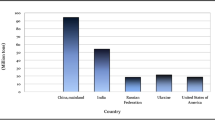Abstract
The increasing number of plastic debris produced worldwide and its detrimental impacts on the environment and human health have led to rising demand for bio-plastic, or polyhydroxyalkanoate, as a replacement to synthetic plastic manufactured from petroleum. The usefulness of agricultural waste as a prime source of carbon for Polyhydroxyalkanoate production and aids in the valorization of the waste. The study optimizes sulfuric acid pre-treated wheat straw (SAPWS) along with inoculum size, temperature, and incubation period using Box-Behnken design (BBD). The maximum Polyhydroxyalkanoate (PHA) yield (0.250 g/L) and productivity (0.521%) by Bacillus paranthracis RSKS-3. were found at 10 g/L SAPWS, 5% inoculum size, 7.4 pH, and 48 h of the incubation period. The observed estimations were in statistical accord with the anticipated values of 0.247 g/L and 0.508%. Based on PHA production using SAPWS as a carbon source, 1.2 g/L was produced with was 5.29-fold increment as compared to standard glucose (10 g/L) that produced 0.34 g/L PHA. The characteristic properties of extracted PHA were similar to the standard PHA. Conclusively, agricultural waste possibly will be utilized as an alternative and a renewable feedstock for green synthesis of PHA production.
Graphical Abstract






Similar content being viewed by others
References
Koul B, Yakoob M, Shah MP (2022) Agricultural waste management strategies for environmental sustainability. Environ Res 206:112285. https://doi.org/10.1016/J.ENVRES.2021.112285
Memon SA, Wahid I, Khan MK et al (2018) Environmentally friendly utilization of wheat straw ash in cement-based composites. Sustainability 10:1322. https://doi.org/10.3390/SU10051322
Singh R, Yadav DB, Ravisankar N et al (2020) Crop residue management in rice–wheat cropping system for resource conservation and environmental protection in north-western India. Environ Dev Sustain 22:3871–3896. https://doi.org/10.1007/S10668-019-00370-Z/FIGURES/3
Malinauskaite J, Jouhara H, Czajczyńska D et al (2017) Municipal solid waste management and waste-to-energy in the context of a circular economy and energy recycling in Europe. Energy 141:2013–2044. https://doi.org/10.1016/J.ENERGY.2017.11.128
Schirmeister CG, Mülhaupt R (2022) Closing the carbon loop in the circular plastics economy. Macromol Rapid Commun 43:2200247. https://doi.org/10.1002/MARC.202200247
Kumar S, Gandhi P, Yadav M et al (2019) Weak alkaline treatment of wheat and pearl millet straw for enhanced biogas production and its economic analysis. Renew Energy 139:753–764. https://doi.org/10.1016/J.RENENE.2019.02.133
Bhattacharyya P, Bisen J, Bhaduri D et al (2021) Turn the wheel from waste to wealth: economic and environmental gain of sustainable rice straw management practices over field burning in reference to India. Sci Total Environ 775:145896. https://doi.org/10.1016/J.SCITOTENV.2021.145896
Ma Y, Shen Y, Liu Y (2020) State of the art of straw treatment technology: challenges and solutions forward. Bioresour Technol 313:123656. https://doi.org/10.1016/J.BIORTECH.2020.123656
Zlati F (2019) Production and detection of polyhydroxybutyrate by Azohydromonas lata. Doctoral dissertation, Hochschule Rhein-Waal
Tyagi P, Sharma A (2021) Utilization of crude paper industry effluent for Polyhydroxyalkanoate (PHA) production. Environ Technol Innov. https://doi.org/10.1016/J.ETI.2021.101692
de Souza L, Manasa Y, Shivakumar S (2020) Bioconversion of lignocellulosic substrates for the production of polyhydroxyalkanoates. Biocatal Agric Biotechnol 28:101754. https://doi.org/10.1016/J.BCAB.2020.101754
Aramvash A, Akbari Shahabi Z, Dashti Aghjeh S, Ghafari MD (2015) Statistical physical and nutrient optimization of bioplastic polyhydroxybutyrate production by Cupriavidus necator. Int J Environ Sci Technol 12:2307–2316. https://doi.org/10.1007/S13762-015-0768-3
Zheng Q, Zhou T, Wang Y et al (2018) Pretreatment of wheat straw leads to structural changes and improved enzymatic hydrolysis. Sci Rep. https://doi.org/10.1038/S41598-018-19517-5
Liu H, Chen Y, Zhang Y et al (2022) Enhanced production of polyhydroxyalkanoates in Pseudomonas putida KT2440 by a combination of genome streamlining and promoter engineering. Int J Biol Macromol 209:117–124. https://doi.org/10.1016/J.IJBIOMAC.2022.04.004
Keenan TM, Nakas JP, Tanenbaum SW (2006) Polyhydroxyalkanoate copolymers from forest biomass. J Ind Microbiol Biotechnol 33:616–626. https://doi.org/10.1007/S10295-006-0131-2
Moorkoth D, Nampoothiri KM (2016) Production and characterization of poly(3-hydroxy butyrate-co-3 hydroxyvalerate) (PHBV) by a novel halotolerant mangrove isolate. Bioresour Technol 201:253–260. https://doi.org/10.1016/J.BIORTECH.2015.11.046
Ashby RD, Qureshi N, Strahan GD et al (2022) Corn stover hydrolysate and levulinic acid: Mixed substrates for short-chain polyhydroxyalkanoate production. Biocatal Agric Biotechnol 43:102391. https://doi.org/10.1016/J.BCAB.2022.102391
Asad-ur-Rehman AA, Masood R et al (2016) Production and characterization of a thermostable bioplastic (poly-β-hydroxybutyrate) from Bacillus cereus NRRL-B-3711. Pak J Bot 48:349–356
Hong K, Sun S, Tian W et al (1999) A rapid method for detecting bacterial polyhydroxyalkanoates in intact cells by Fourier transform infrared spectroscopy. Appl Microbiol Biotechnol 51:523–526. https://doi.org/10.1007/S002530051427/METRICS
Trakunjae C, Boondaeng A, Apiwatanapiwat W et al (2021) Enhanced polyhydroxybutyrate (PHB) production by newly isolated rare actinomycetes Rhodococcus sp. strain BSRT1-1 using response surface methodology. Sci Rep 11:1–14. https://doi.org/10.1038/s41598-021-81386-2
El-malek FA, Farag A, Omar S, Khairy H (2020) Polyhydroxyalkanoates (PHA) from Halomonas pacifica ASL10 and Halomonas salifodiane ASL11 isolated from Mariout salt lakes. Int J Biol Macromol 161:1318–1328. https://doi.org/10.1016/J.IJBIOMAC.2020.07.258
Behera S, Priyadarshanee M, Vandana DS (2022) Polyhydroxyalkanoates, the bioplastics of microbial origin: properties, biochemical synthesis, and their applications. Chemosphere 294:133723. https://doi.org/10.1016/J.CHEMOSPHERE.2022.133723
Dubey S, Mishra S (2022) Natural sea salt based polyhydroxyalkanoate production by wild Halomonas hydrothermalis strain. Fuel 311:122593. https://doi.org/10.1016/J.FUEL.2021.122593
Author information
Authors and Affiliations
Corresponding author
Ethics declarations
Conflict of Interest
There was no competing interest found during the study.
Additional information
Publisher's Note
Springer Nature remains neutral with regard to jurisdictional claims in published maps and institutional affiliations.
Rights and permissions
Springer Nature or its licensor (e.g. a society or other partner) holds exclusive rights to this article under a publishing agreement with the author(s) or other rightsholder(s); author self-archiving of the accepted manuscript version of this article is solely governed by the terms of such publishing agreement and applicable law.
About this article
Cite this article
Sachan, R.S.K., Devgon, I., Rajput, K. et al. Polyhydroxyalkanoate Production Using Sulfuric Acid Pre-Treated Wheat Straw (SAPWS) as a Feedstock: RSM (Response Surface Methodology)-Based Optimization Using Bacillus paranthracis RSKS-3. Indian J Microbiol (2024). https://doi.org/10.1007/s12088-024-01261-2
Received:
Accepted:
Published:
DOI: https://doi.org/10.1007/s12088-024-01261-2




